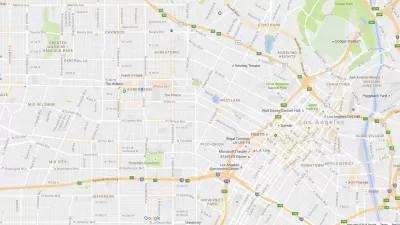Google Maps has changed a lot since its quick rise to ubiquity. An intrepid blogger digs into the nitty gritty of how the mapping platform has changed, and the consequences of Google's cartography for how the public perceives the world.

Justin O'Beirne examines the effects of several years of changes to the cartography of Google Maps—perhaps the most popular of the online mapping programs.
Browsing Google Maps over the past year or so, I've often thought that there are fewer labels than there used to be. Google's cartography was revamped three years ago – but surely this didn't include a reduction in labels? Rather, the sparser maps appear to be a recent development.
After digging into side-by-side comparisons of screengrabs taken from Google Maps in 2010 and 2016, O'Beirne notices obvious, and consequential, changes. For instance, Google Maps now has fewer city labels but more roads. In effect, explains O'Beirne, Google Maps has become a network map. "The cities are the nodes. And the roads are the paths between the nodes." [Emphasis in the original.]
O'Beirne concludes that both the 2010 and the 2016 versions of Google Maps suffer from a lack of balance between cities and roads. He does, however, offer an example of a map that achieves this balance more effectively, and even imagines what a Google map of Chicago would look like if it were balanced correctly.
FULL STORY: WHAT HAPPENED TO GOOGLE MAPS?

Alabama: Trump Terminates Settlements for Black Communities Harmed By Raw Sewage
Trump deemed the landmark civil rights agreement “illegal DEI and environmental justice policy.”

Study: Maui’s Plan to Convert Vacation Rentals to Long-Term Housing Could Cause Nearly $1 Billion Economic Loss
The plan would reduce visitor accommodation by 25% resulting in 1,900 jobs lost.

Planetizen Federal Action Tracker
A weekly monitor of how Trump’s orders and actions are impacting planners and planning in America.

Wind Energy on the Rise Despite Federal Policy Reversal
The Trump administration is revoking federal support for renewable energy, but demand for new projects continues unabated.

Passengers Flock to Caltrain After Electrification
The new electric trains are running faster and more reliably, leading to strong ridership growth on the Bay Area rail system.

Texas Churches Rally Behind ‘Yes in God’s Back Yard’ Legislation
Religious leaders want the state to reduce zoning regulations to streamline leasing church-owned land to housing developers.
Urban Design for Planners 1: Software Tools
This six-course series explores essential urban design concepts using open source software and equips planners with the tools they need to participate fully in the urban design process.
Planning for Universal Design
Learn the tools for implementing Universal Design in planning regulations.
Caltrans
Smith Gee Studio
Institute for Housing and Urban Development Studies (IHS)
City of Grandview
Harvard GSD Executive Education
Toledo-Lucas County Plan Commissions
Salt Lake City
NYU Wagner Graduate School of Public Service




























